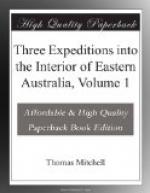We had now tried the course pointed out by The Bushranger, and, having found that it was wholly impracticable, I determined upon returning to Tangulda, and by pursuing the Namoi to endeavour to turn this range and so enter the region beyond it. With this resolution I moved back to the depot, which we left in the morning, and having reached it, made preparations to retrace our course. Mr. White followed Maule’s river for some miles to the westward, so that we could judge of the direction in which it fell into the Namoi. This evening as Burnett, the carpenter, was seated beside a pool with his gun, silently engaged in watching some ducks, two natives approached on the opposite side to fill a small vessel with water, they looked around very cautiously, as if conscious that we were near, but Burnett very prudently did not allow them to see him.
December 21.
The whole party having started early, we this day reached the former encampment near Tangulda, a distance of twenty-one miles, in seven hours.
December 22.
I set out before the party moved off, in order to mark the line of route for the carts, and to fix on a spot for the camp. I rode over firm and level ground, on a bearing of 295 degrees, which I knew would bring me to the little hill observed from Tangulda, where the Namoi passes to the lower country beyond. The morning was so foggy that I could see none of the hills. The perfume from the recently burnt bushes of Acacia pendula was most fragrant, and, to me, quite new. At six miles I came upon the river which was flowing rapidly northward. Its deeper bed and sparkling waters looked very different from the stagnant lagoon we had left that morning. The grass along the banks was excellent, and on the little hill beside the river hung pines (Callitris pyramidalis) in abundance. Lofty bluegum-trees grew on the margin of the stream, and the place, upon the whole, seemed favourable for the formation of a depot, where I might leave the cattle to refresh while proceeded down the Namoi in the canvas boats, with the materials for constructing which, we were provided. This river was the channel of the united waters of the Peel, Muluerindie and Conadilly. Some of these streams traversed extensive plains, subject to inundation, but the low rocky hills in this neighbourhood afforded perfect security. The country smoked around us on all sides; and the invisible blacks, The Barber’s allies, were not well disposed towards us, but in a position like this our depot would be secure.
PREPARE TO LAUNCH THE BOATS ON THE NAMOI.
I accordingly made preparations for constructing our boats and launching them on the Namoi as soon as possible. With four adjoining trees cut off at equal height, we formed a saw-pit, and a small recess which had been worked in the bank by the floods served as a dock in which to set up and float the boats. We had fixed upon this spot because it appeared more favourable for launching than that higher up the river, where the water was shallower, and drift timber lay across it.




